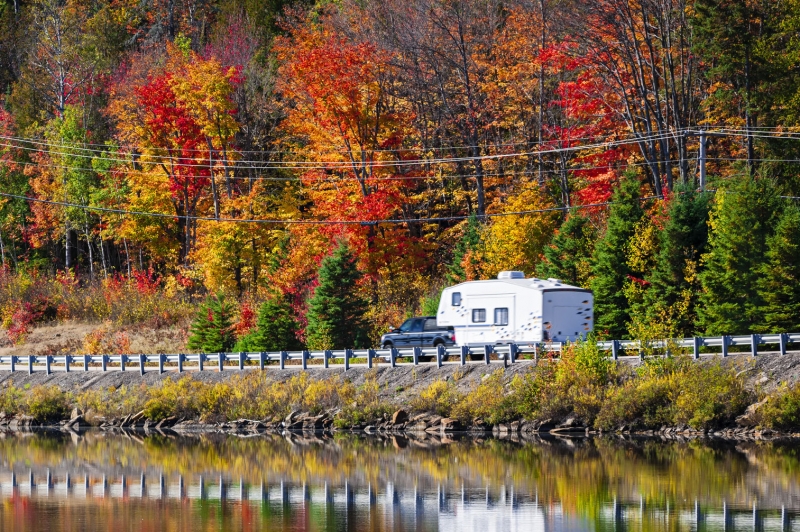These trip planning tips are useful for every trip you take during the year.
Have travel plans this holiday season? Or plans to go somewhere this winter? If it’s somewhere you’ve never been, or it’s been a long time, then you’ll need to prepare for your trip ahead of time so that you arrive to your final destination without incident.
Sit down and look at the route before you leave your driveway.
You wouldn’t just blindly pick a campground and campsite. You do your research. The same should happen when getting to and from a destination, whether it’s a campground or a friend’s house. Check over the route ahead of time to become aware of construction zones (see below), attractions you might be passing on the way, and roadside stops. You also want to make sure there aren’t any low clearances on the way, if you have a tall RV that might need the extra height.
Have apps on your device and know how to use them.
Almost certainly, you’ll be bringing the smartphone and tablet along. The creation and availability of apps for these devices has been helpful for trip planning, navigating, and making decisions on the road. Here are some apps – other than the ones your phone already comes equipped with (i.e., Apple Maps or Google Maps) – that might prove useful for you. Make sure to download any app and become familiar with it before your trip so that you aren’t wasting time – and possibly an exit – trying to figure out how to use it.
- inRoute (iOS): This offers voice guided navigation; automatic severe weather alerts; interactive charts; alternative routes; export to Google Maps, Apple Maps, MapQuest, and others; and offline capability.
- Co-Pilot GPS (iOS / Android / Windows): This app offers truck-specific GPS navigation, which could help owners of larger RVs manage to avoid restrictive routes or low clearances. Easy to read and understand, this app could be a replacement for your phone’s default GPS or the one on your dash.
- Gas Buddy ((iOS / Android / Windows/Blackberry): Find the cheapest gas nearest you or search for a gas station by location. This app compares gas prices so that you can make a decision – and save money. However, keep in mind that the gas station you want may not be the best one to stop at with a tall or long RV.
- All Stays Truck & Travel (iOS / Android): With large and lengthy RVs, utilizing the same truck stops, travel centers, weigh stations, and rest stops as big semi-trucks makes sense. It’ll also show detailed amenities such as Internet, ATMs, and food options for each stop.
- Route-1 by LowClearances.com: According to a press release, “Route-1 is a database of more than 5,000 low clearances on major and minor roads in the United States and Canada. It works with popular low-cost GPS and mapping systems such as Garmin, TomTom, Rand McNally, MapSource, Google Earth, Microsoft Streets & Trips, and BaseCamp. It is also compatible with iOS & Android devices (TomTom & Google Earth Apps only).” Though created for professional drivers, it will help RVers simplify their trip planning.
- Wind Compass (iOS): Wind Compass gets your current location and then the current weather conditions based on that location. No fuss, no configuration, just quick weather readouts. The wind may feel like it’s going to push you and your rig over, but it may not be as strong as you think. On the flip side, the colder the air (fall and winter), the stronger the wind at any speed. So a 20mph wind in July isn’t the same as in December. This may affect your travel plans.
Keep the printed map.
We’ve all gotten used to following the monotonous voice of the GPS or having our copilot utilize their smartphone for directions or to find the nearest gas station. But as a safeguard in case a battery is low, a device is on its way out, there is no signal because you’re in a bad area or there’s been a recent disaster with so many calls that they’re clogging up the towers, then you need to have a road atlas or printed directions from Google Maps or Mapquest beside you in case you need another reference.
Check for construction.
It’s Michigan, so a road is always being worked on. This can create big backups during high traffic times of the day and with heavy holiday traffic, especially near metro areas. You can check the Michigan Department of Transportation map to look at where construction is located. On the road, you can check this website to check for traffic incidents as well, though there are apps that will also help you navigate your way to best avoid bottlenecks.
Check the weather.
Michigan weather can be finicky, to say the least. Look at the forecast a few days in advance as well as the day of your trip. Watch for systems and pockets of poor weather that might be in the area you’re traveling through. Even when you get on the road, the weather can change quickly. If you grow uncomfortable with the weather, it’s better to be safe and delay making headway, such as if there are high winds, than to push your way through.

